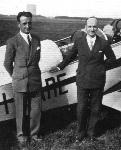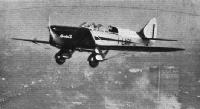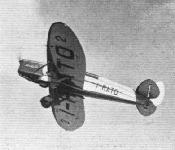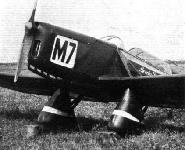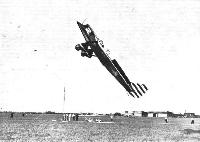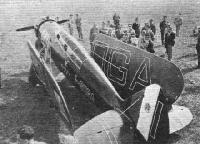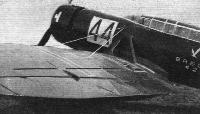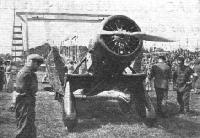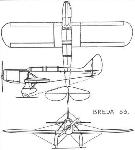
Breda Ва 33 и Ва 39
Ва 33, спроектированный в 1931 году, вскоре привлек международный интерес, когда в том же году шеф-пилот фирмы "Breda" Амброзио Коломбо победил на нем во вторых авиагонках по Италии. Легкий низкоплан Ва 33 с двумя сидящими друг за другом летчиками был передовой по тем временам разработкой, с плавными обводами и минимумом подкосов и расчалок. Кроме того, Ва 33 был первым из спортивных и туристических самолетов фирмы "Breda" с установленными на крыльях закрылками и автоматическими предкрылками. Экипаж обычно сидел под застекленными фонарями, но, по крайней мере, одна машина летала с открытыми кабинами. На Ва 33 ставили двигатель de Havilland Gipsy III мощностью 120 л.с. (90 кВт). Самолет отличался экономичностью и хорошими летными данными, в том числе превосходной скороподъемностью, мог взлетать и садиться с коротким разбегом и пробегом.
Ва 33 совершил ряд дальних перелетов, включая перелет Лондон-Калькутта в 1933 году, а также завоевал ряд спортивных призов. Партию из 10 самолетов купили ВВС Италии для службы связи. Одну машину в 1932 году продали в Японию. Под обозначением Ва 33S разработали также одноместную спортивную и гоночную версию.
Ва 39 - это более крупная и тяжелая модификация Ва 33. Он впервые взлетел в сентябре 1932 года и продемонстрировал не столь высокие, как у предшественника, летные качества. Тем не менее Ва 39 достиг успеха в спортивных соревнованиях и совершил несколько выдающихся полетов на дальность.
Самолет оценили в качестве связного. К производству гражданских машин добавились военные заказы. Из поставленных ВВС 60-ти самолетов около 20 были сделаны для использования внутри страны под обозначением Ва 39 Met (для метрополии), а еще 20 для службы за границей под обозначением Ва 39 Col (для колоний).
Варианты
Ва 39S: версия 1934 года с трехместной кабиной
Ва 42: малую серию этого варианта собрали в 1934 году, изменили силовую установку: один звездообразный двигатель Fiat A.70S с капотом NACA мощностью 180 л. с. (134 кВт) и специально спроектировали клапанные щели в передней кромке крыла вместо прежних отклоняемых предкрылков
ТАКТИКО-ТЕХНИЧЕСКИЕ ХАРАКТЕРИСТИКИ
Breda Ва 39
Тип: двухместный самолет для туризма и связи
Силовая установка: рядный двигатель Colombo S.63 мощностью 140 л. с. (104 кВт)
Летные характеристики: максимальная скорость 220 км/ч на оптимальной высоте; набор высоты 4000 м за 21 мин; практический потолок 6000 м; радиус действия 900 км; продолжительность полета 3ч 30мин
Масса: пустой самолет 560 кг; максимальная взлетная 935 кг
Размеры: размах крыла 10,41 м; длина 7,44 м; высота 2,95 м; площадь крыла 17,50 м1
Описание:
- Breda Ва 33 и Ва 39
- Flight, August 1932
The "Breda 33”
Фотографии
-
Flight 1931-07 / Flight
One of types of monoplane in the Circuit of Italy race. The new Breda 33 ("Gipsy III") low wing monoplane.
-
Flight 1931-09 / Flight
Регистрационный номер: I-LARE [5] A side view of the Breda 33 ("Gipsy III") monoplane.
-
Flight 1931-07 / Flight
Регистрационный номер: I-LARE [5] Two views of the Breda 33 Monoplane ("Gipsy III"), showing the sliding windows to the cockpit open and closed.
-
Aeroplane Monthly 1979-04 / Stag Lane /Gone but not forgotten/ (1)
Регистрационный номер: I-ABFX This Italian Breda 33, I-ABFX, visited in March 1933.
-
Flight 1931-08 / Flight
Регистрационный номер: I-LARE [5] THE WINNER: Colombo's "Breda 33" (Gipsy III), with cockpits open. Transparent panels turn the machine into a cabin monoplane.
-
Flight 1931-07 / Flight
Регистрационный номер: I-RATO [3] Sig. ing. Ambrogio Colombo, who was the first to arrive at Palermo on a Breda 33 monoplane. He was the winner of the Circuit of Italy Air Race. He was flying one of the New Breda 33 low-wing monoplanes, fitted with a Gipsy III engine.
-
Flight 1931-09 / Flight
Регистрационный номер: I-LARE [5] Sig. Meleri (pilot) and Sig. L. Monaco (a Director of the Breda Co.), who flew from Milan to Croydon in 5 1/2 hours in the Breda 33.
-
Flight 1931-08 / Flight
MINISTERIAL INTEREST: General Balbo, Italy's Air Minister, examining one of the "Breda 33" machines.
-
Flight 1931-08 / Flight
IL DUCE AS A STARTER: Signor Mussolini dropping his flag and starting Meleri off.
-
Flight 1932-01 / Flight
MILAN-MADRID NON-STOP: Sig. Meleri, last December, made a fine non-stop flight from Milan to Madrid, a distance of 930 miles in 7 hr. 18 min. - an average speed of 127 m.p.h. - in the Breda 33 (120-h.p. "Gipsy"). Our picture shows him (on extreme right) at Lisbon during a subsequent visit standing next to Maj. Pinheiro Correia, Commandant of the Portuguese Independent Bombing Squadron, and L. Monaco, a Director of the Breda Co.
-
Flight 1931-09 / Flight
Регистрационный номер: I-LARE [5] -
Flight 1931-08 / Flight
Регистрационный номер: I-RATO [3] ON THE WAY: One of the "Breda 33's" (Gipsy III) in flight.
-
Flight 1932-01 / Flight
MILAN-MADRID NON-STOP: Sig. Meleri, last December, made a fine non-stop flight from Milan to Madrid, a distance of 930 miles in 7 hr. 18 min. - an average speed of 127 m.p.h. - in the Breda 33 (120-h.p. "Gipsy"). Our picture shows him landing at Madrid
-
Air-Britain Archive 1987-01
Регистрационный номер: G-ABXK [3] Breda 33 G-ABXK was used by owner Miss Winifred E.Spooner in the 1932 Circuit of Europe (which we assume to be the same as the Rundflug of 8.32 quoted elsewhere) and was cancelled in September 1932, dismantled and crated at Heston for return to Breda. There our records lose track of it - can any reader supply more details?
-
Flight 1932-08 / Flight
Регистрационный номер: G-ABXK [3] MISS SPOONER'S "BREDA 33": The wheels are carefully faired in, and have a travel of nearly one foot (including the deflection on the tyres). The slots extend over the whole wing span. The engine is a de Havilland "Gipsy III."
-
Flight 1934-04 / Flight
THE ALTITUDE RECORD: Renato Donati, who has just captured the world's altitude record for Italy.
-
Flight 1932-08 / Flight
Регистрационный номер: G-ABXK [3] WEIGHED AND NOT FOUND WANTING: A Plan View of Miss Spooner's Breda 33 ("Gipsy III" engine). Miss Spooner herself may (or may not) be recognised near the starboard wing.
-
Flight 1932-08 / Flight
Регистрационный номер: I-BLEA BEETLES AT BERLIN: On the left the Swiss Comte 12E ("Gipsy III") and on the right one of the Breda 33 (Colombo S.63) monoplanes.
Другие самолёты на фотографии: Comte AC-4 Gentleman / AC-8 / AC-12 Moskito - Швейцария - 1927
-
Flight 1932-08 / Flight
SOME OF THE FOREIGN COMPETITORS: In the foreground the French machines, Guerchais, Potez, Farman and Caudron.
on the right background - Italian team, with Breda Ba-33 aircraft (first to the right - pilot Miss Winifred Spooner)Другие самолёты на фотографии: Breda Ba.15 - Италия - 1928Caudron C.230 / C.270 / Luciole - Франция - 1930Farman F.230 / F.350 - Франция - 1930Guerchais T.9 - Франция - 1930Mauboussin Corsaire / M-120 - Франция - 1932Potez Potez 43 / 58 - Франция - 1932Praga BH-111 - Чехословакия - 1932PZL PZL.19 - Польша - 1932RWD RWD-6 / RWD-9 / RWD-20 - Польша - 1932
-
Flight 1932-08 / Flight
FOR SMOOTH RUNNING: The Colombo engine fitted in the Breda 33 machines is of the 6-cylinder, in-line, type.
-
Flight 1932-08 / Flight
Регистрационный номер: I-CTUS "THAT'S A BREDA 33 THAT WAS": Lombardi taking his fences in great style.
-
Flight 1931-08 / Flight
Регистрационный номер: I-RATO [3] AT REST: One of the "Breda 33's" with wings (what little there is of them) folded.
-
Мировая Авиация 71
Регистрационный номер: I-GARD Хотя мощность мотора Ва 39 (на фотографии) была выше, чем у Ва 33, его максимальная скорость оказалась гораздо ниже из-за увеличенной на 205 кг массы.
ONLY BREDA 39 still in flying condition, I-GARD is a tandem two-seat cabin tourer powered by a 130-h.p. Colombo S.63 in-line. -
Flight 1933-10 / Flight
PRINCE NICHOLAS IN ITALY: During his recent stay in Italy, Prince Nicholas of Roumania visited several aircraft factories. He is shown here in the front cockpit of a Breda 39 after flying this machine, accompanied by Ing. A. Colombo (rear cockpit). Standing on the left is Count Sagramoso, Managing Director of the Breda Company.
-
Flight 1933-12 / Flight
Регистрационный номер: I-ACIE SLOTS: Guglielmotti's Breda in the take-off and landing tests.
-
Flight 1934-09 / Flight
Регистрационный номер: I-GOGA [3] DURING THE WING-FOLDING TESTS: The Breda BA 42
-
Flight 1934-09 / Flight
Регистрационный номер: I-GOGA [3] On the Breda 42 the slots are automatic in action.
-
Flight 1931-08 / Flight
Breda 33 Gipsy III Engine
-
Flight 1932-08 / Flight
Breda 33
- Фотографии






